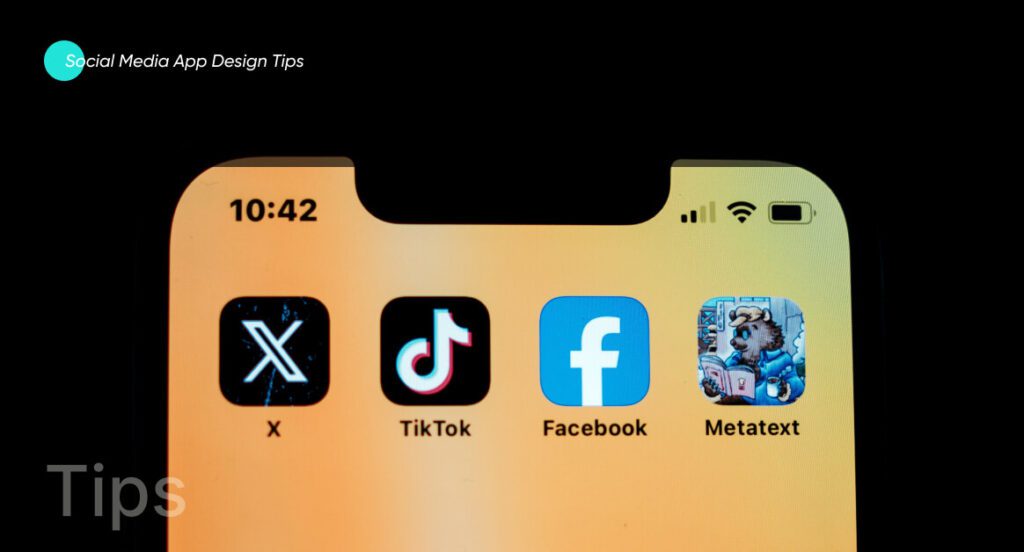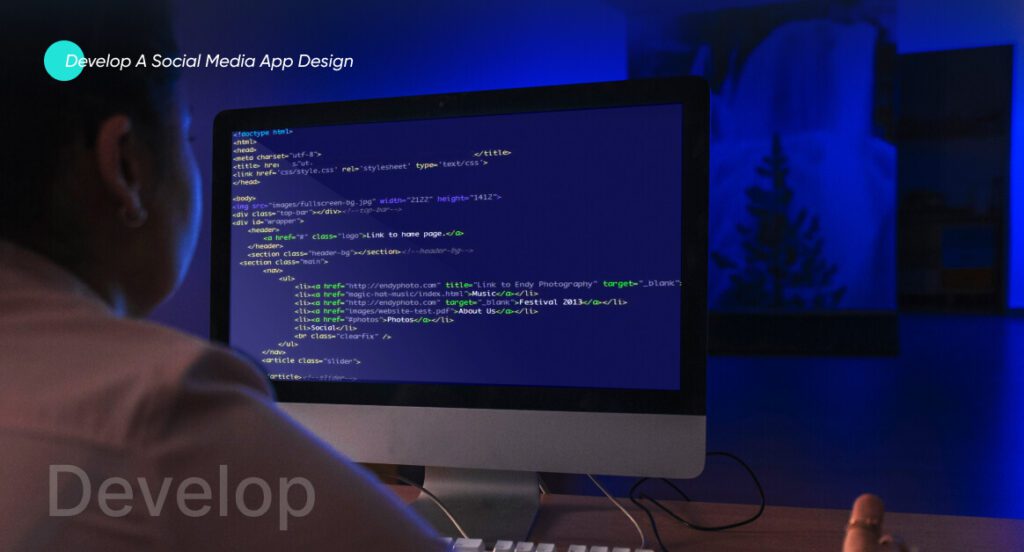How To Create A Social Media App Design
Social media came along in 1996; since then, it has penetrated the lives of more than half of the world’s population. According to Statista, more than 4.59 billion social media users spend more than 150 minutes on social media apps daily.
Today, social media is the most powerful tool of influence. It impacts all our lives and influences politics, education, culture, and, most importantly, businesses. To engage and retain your customers, you must design a social media app offering users a seamless interface and experience. Social media users are exposed to numerous applications daily, and you need to be appealing to stay relevant. Social media app design forms the backbone of an app’s appeal. Hence, focusing on it is essential!
While there is high ROI potential in social media app designing, it is still a reasonably intricate field. You must understand social media app UI and UX and their impact on brand awareness and content relatability. Developing and designing such an application requires experts to help you navigate this complicated journey. The social media industry is one of the best industries to invest in. If you’re looking into designing a social media app, this is prime time!
In this blog, we will share valuable tips on how to design a social media app. It will familiarize you with everything you need to know and its eventual impact on your strategic goals. Let’s dive in!
Types Of Social Media Apps
It’s essential to understand the type of platform you’d like to create for your target audience before you decide to design one. Here’s a cohesive list of various kinds of social media platforms:
1. Social Networking Apps
If you want to make professional networking easier and foster vibrant personal connections, a social networking app is just what you need. These creative applications help you stay connected with people by linking them with new and old contacts and expanding your social circle. For example, applications like LinkedIn, Facebook, Instagram, and MeWe revolutionize how you create and build your social network and tap opportunities.


2. Blogging and Publishing Apps
To create a community that writers can use to facilitate their creative process, you should invest in designing a blogging and publishing app. These applications help writers capture their thoughts and ideas anywhere, anytime! These platforms are an aspiring wordsmith’s go-to platform. For example, Dribbble and Medium are popular applications writers use to redefine their writing experience.
3. Media Sharing Apps
If you want to create an application like YouTube, Instagram, Pinterest, or Snapchat, you are interested in a social media app design that caters to modern digital interaction. These apps offer a dynamic platform for users to share photos, videos, GIFs, etc. These applications help creators exchange ideas, collaborate with others, and elevate their content.


4. Service Provider Apps
If you want to design a social network that provides seamless solutions to users, then a service provider app is your best bet. These applications supply a platform for users to access various services reliably and effortlessly with just a few taps. For example, applications like Ola and UrbanCompany help redefine on-demand services and create a user-friendly and seamless consumer experience.
5. Customer Review Apps
These applications are used to articulate experiences with brands by users. They share their reviews on specific products and services with millions of people. Positive feedback has a significant influence on a business’s growth. Some great examples of such applications are Yelp, Ambition Box, Glassdoor, and TripAdvisor. These applications seamlessly integrate user insights into a brand image and redefine the success of a business.


6. Discussion Forums
Discussion forum apps have a social media app design that fosters a community where users share insightful experiences, ideas, and opinions with others. It promotes meaningful conversations and intellectual curiosity that help people connect. For example, platforms like Quora are used widely by users to discuss anything and everything.
Now that you know which app aligns with your business goal, let’s explore some popular social media app design ideas.
Significance of Social Media App Design

Designing a social media app significantly influences its success or failure. The history of social media platforms like MySpace, Orkut, Friendster, and Vine serves as a valuable lesson, highlighting the pivotal role of UI/UX in shaping user perceptions and engagement.
Despite initial popularity, these platforms faced a downfall primarily due to poor design choices.
- MySpace struggled with an interface that lacked organization and had faulty technology.
- With its early success, Orkut encountered issues such as slowing speed, complex UI, and privacy concerns.
- Friendster failed to adapt due to missing social interaction features and a lack of recent improvements.
- Vine’s failure can be attributed to its rigid adherence to a 6-second video format, ignoring user needs.
Hence, it is essential to have a user-friendly and customer-centric design. It eventually determines the fate of a social media app. A well-thought-out UI/UX attracts users and influences their overall experience, encouraging continuous and repeated engagement. The success of an application depends on its ability to prioritize designs that align with user preferences, making it accessible and appealing.
Social Media App Design Tips

Creating a highly optimized and unique social network app is challenging. You must add various features and ensure your social network app design is user-friendly, appealing, and natural. Here are some of the basic guidelines that you should follow when you’re designing a social media app.
1. Simplicity
Simplicity is the best policy when it comes to social media app design. Users prefer using an application that is simple and to the point. It adds value to a brand and makes it easier for users to navigate your application.
2. Communication
Your social media app is all about connecting and networking with people. Hence, your app should give users as many opportunities to interact with each other as possible. Moreover, your app design should encourage communication too. For example, add audio and video calls, text messaging, and voice notes to engage users, facilitate communication, and grow your community.
3. Easy Navigation
Adding minimal and simple navigation is advised when designing a social media app. Most users cannot keep up with applications that have complex navigation. Hence, add all your buttons and icons at the bottom or top of the screen so the user can quickly see and recognize them.
4. Personalization
Users must be free to interact with your social media application as they please. They should be asked whether they’d like to volunteer information about themselves. Moreover, they should be allowed to add media, links, bios, and other personal information to their profiles.
5. Aesthetically Pleasing
Your application must be aesthetically pleasing to the user’s eye. Follow color codes and choose colors that complement each other. A vibrant and aesthetically pleasing application always pulls a user in. Moreover, stick to the color scheme of your brand logo or use a contrasting palette that complements your logo.
6. Add Round Designs
Social media apps often, if not always, have round profile picture icons. These round designs help users recall another user and bring their attention to their faces.
7. Sync Everything
Your app design should focus on keeping things synchronized for user ease. Being consistent and streamlined helps your app have a logical structure so consumers can find what they want. It also helps reduce user frustration and improves user experience.
How Do You Develop a Social Media App Design?

Here is a step-by-step guide for designing a social media app:
Step 1 – Identify Intent, Competitors, and Target Audience
A seasoned social media app developer will always ask you about the purpose of your application before diving into design. Hence, ensure you understand what you want to achieve with this app and properly communicate what you’ve concluded to the developer.
You also need to have a good understanding of your target market. A detailed knowledge of your current and potential users unlocks more opportunities for you to retain them.
Moreover, it is crucial to do a thorough app competitor analysis to see what your competitor lacks and what can slowly but surely become your competitive advantage. After detailed market research, you’re ready to build growth and development strategies.
Step 2- Design Social Media App Flow
The second step focuses on creating a distinct workflow. In this step, you map out a user’s specific steps and interactions with the application. Hence, it is a detailed visualization of a user’s journey with the social media app.
Designers and developers follow this step religiously to ensure a seamless user experience. They outline user goals, personas, entry points, navigation structure, notifications, feedback mechanisms, decision points, error handling, and iterative refinement.
Step 3- Design and Development for Android and iOS
In the third step of app development, the social media app design is defined for both Android and iOS users. Developers start by focusing on creating comprehensive wireframes. Wireframes help outline the fundamental appearance and functionality of the application. It gives an eagle’s eye view of the application by offering developers a visual representation of how each element will be laid out and how a user will navigate it.
After wireframing is finalized, the next stage in development and social media app design is prototyping. Here, a tangible working model is created for the app for a preview. It helps determine app functionality for both Android and iOS platforms. This step is essential for adjustments and error handling.
By adopting a systematic approach through wireframing and prototyping, you not only provide a clear visual guide for your design and development teams but also pave the way for a more seamless and cohesive user experience across diverse platforms. This step process lays the foundation for the subsequent phases of development, ensuring that the final product resonates with users on both Android and iOS devices.
See our latest relevant exploration Social Media App Development Cost
![]()
Step 4- Build Your Community
The last step comes into play after you’ve developed and launched your app. Now, you need to work on winning users, connecting with them, and building a community. Start by launching a successful and comprehensive marketing campaign to create a buzz.
Use other popular social media platforms to establish a presence and identity for your brand. Share engaging content, updates, and sneak peeks about what’s to come. Collaborate with celebrities and influencers who align with your brand ideology and niche.
Moreover, it focuses on App Store Optimization (ASO), referral programs, email marketing, content marketing, beta testing, and paid advertising. It is also essential to constantly analyze your application’s performance and improve it based on business strategies, data insights, and user feedback.
Design your social media application with us. See our Social Network Development Service ![]()
FAQs
Building an app like Threads requires you to specify the application’s purpose, create intuitive UI and UX, develop the backend and front end, test the app, and then deploy and launch the application. Incorporate features like automated account following, enhanced messaging, and cross-platform compatibility. Moreover, building an application like Threads costs anywhere from $55,000 to $300,000. This is a rough estimate and can vary with the complexity of the features incorporated in the application.
You can develop an influencer marketing platform by defining project goals, choosing the right technological methodology, finalizing the design and development approach, completing the coding process, doing QA, and deploying the app for usage. Moreover, it emphasizes simplicity, easy navigation, content quality, profile optimization, and relationship management. Designing such an application can vary from $40,000 to $200,000.
You can make money from a social media app by becoming an affiliate, selling your products directly, partnering with other brands and influencers, starting a membership program, adding sponsored content, promoting special offers, and enrolling in platform-specific monetization platforms.
The most crucial factor when designing a social media app is the user-friendly and straightforward user interface (UI). Make it easy for users to interact with and use your platform for social networking.
Gohar is a seasoned IT writer specializing in leading technologies. He holds a Diploma and Bachelor's degree from the University of London, with professional experience spanning over five years in the IT sector. His expertise involves a keen focus on mobile applications, web apps, blockchain, content management systems, e-commerce, and fintech. Beyond the professional field, Gohar is an avid reader and reads extensively about emerging and innovative technologies.